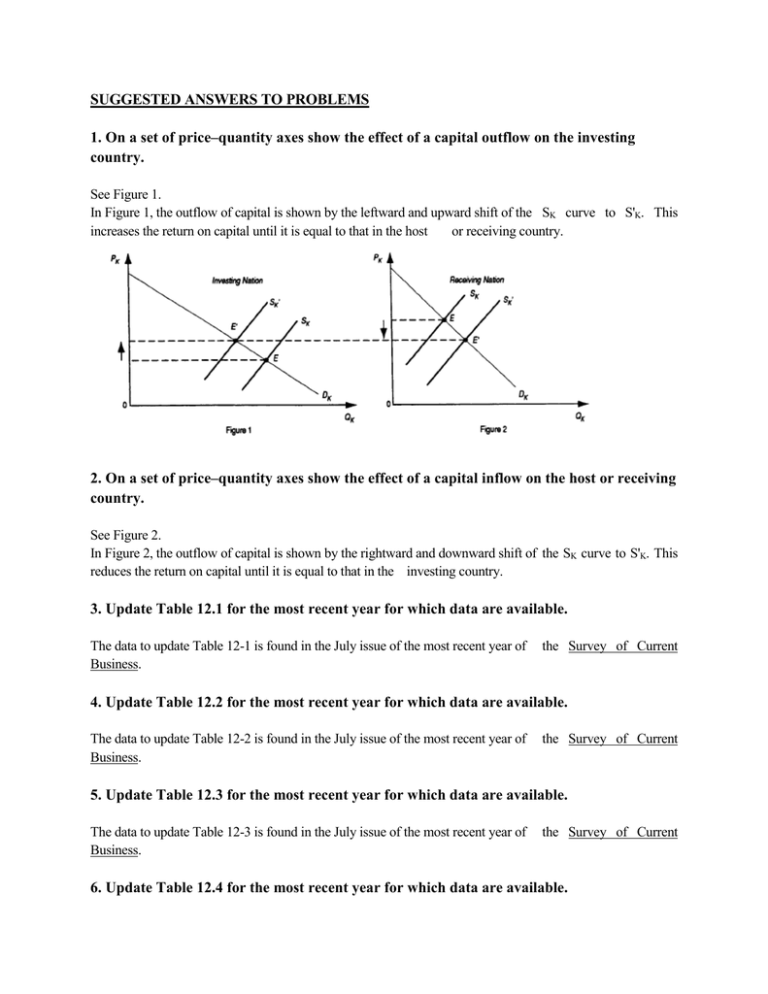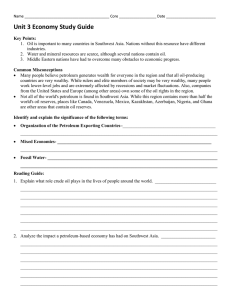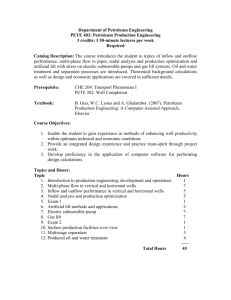Chapter 12 Book Answers
advertisement

SUGGESTED ANSWERS TO PROBLEMS 1. On a set of price–quantity axes show the effect of a capital outflow on the investing country. See Figure 1. In Figure 1, the outflow of capital is shown by the leftward and upward shift of the SK curve to S'K. This increases the return on capital until it is equal to that in the host or receiving country. 2. On a set of price–quantity axes show the effect of a capital inflow on the host or receiving country. See Figure 2. In Figure 2, the outflow of capital is shown by the rightward and downward shift of the SK curve to S'K. This reduces the return on capital until it is equal to that in the investing country. 3. Update Table 12.1 for the most recent year for which data are available. The data to update Table 12-1 is found in the July issue of the most recent year of Business. the Survey of Current 4. Update Table 12.2 for the most recent year for which data are available. The data to update Table 12-2 is found in the July issue of the most recent year of Business. the Survey of Current 5. Update Table 12.3 for the most recent year for which data are available. The data to update Table 12-3 is found in the July issue of the most recent year of Business. the Survey of Current 6. Update Table 12.4 for the most recent year for which data are available. The data to update Table 12-4 is found in the July issue of the most recent year of Business. the Survey of Current *7. Determine whether the following statement is true or false and explain why: ‘‘The profitability of a portfolio of many securities can never exceed the yield of the highest-yield security in the portfolio, but it can have a risk lower than the lowest-risk security.’’ The Statement is true. The profitability of a portfolio is equal to the weighted average of the yield of the securities included in the portfolio. Therefore, the profitability of a portfolio of many securities can never exceed the yield of the highest-yield security in the portfolio. The second part of the statement is also true if the portfolio includes securities for which yields are inversely correlated over time. 8. Draw a figure similar to Figure 12.2 showing equal gains in two nations as a result of capital transfers from Nation 1 to Nation 2. See Figure 3. The gain of the investing country is EGR. 9. Draw a figure similar to Figure 12.2 showing greater gains for Nation 1 than for Nation 2 resulting from capital transfers from Nation 1 to Nation 2. See Figure 4. The gain of the host or receiving country is ERM. 10. What general principle can you deduce from your answer to the previous two problems and from Figure 12.1 as to the distribution of the total gains from international capital transfers between the investing and the host nation? The general principle that can be deduced from the answers to the previous two problems and from Figure 12-1 is that the nation with the more rapidly declining VMPK curve gains more. With the VMPK curves declining at equal rates, both nations gain equal amounts. 11. Explain why the rate of return on U.S. direct investment in developing nations often exceeds the rate of return on investment on U.S. direct investments in developed nations. The rate of return on U.S. direct investment in developing nations often exceeds the rate of return on investment on it investments in developed nations because of relative scarcity of capital and technology and lower wage rates in developing than in developed nations. *12. Using Figure 12.2, explain why organized labor in the United States opposes U.S. investments abroad. U.S. labor generally opposes U.S. investments abroad because they reduce the K/L ratio and the productivity and wages of labor in the United States. *13. Using Figure 12.2, explain why labor in developing nations benefits from an inflow of foreign investments. An inflow of foreign capital leads to an increase in the K/L ratio and in the productivity and wages of labor or employment in developing nations. 14. Update Table 12.6 for the most recent year for which data are available. How has the ranking of the world’s largest MNCs changed since 2006? The data to update Table 12-6 are found in the World Investment Report published yearly by the United Nations for the most recent year. *= Answer provided at www.wiley.com/college/salvatore. SUGGESTED ANSWERS TO PROBLEMS IN APPENDIX Appendix: Problem A12.1 For the period from 1973 to 1980 (the time of the petroleum crisis), construct a table showing (a) the dollar price per barrel of Saudi Arabian petroleum exports, (b) the dollar value of the total exports of the nations belonging to the Organization of Petroleum Exporting Countries (OPEC), (c) the dollar value of the total imports of OPEC, and (d) the dollar value of U.S. petroleum imports. (Hint: Consult the 1981 issue of International Financial Statistics, published by the International Monetary Fund, in your library.) See Table 1. Table 1 (a) (b) (c) Year Petroleum Price OPEC Exports OPEC Imports (US $/barrel) (bill. $) (bill. $) 1973 2.7 39 20.1 1974 9.76 119.3 32.1 1975 10.72 109.8 51.3 1976 11.51 133 62.2 1977 12.4 146 83.8 1978 12.7 141.9 94.9 1979 16.97 208 101.6 1980 28.67 294.2 133.2 Source: International Financial Statistics, 1981 Yearbook. Petroleum prices refer to Saudi Arabian prices (d) US Petroleum Imports (bill. $) 7.6 26.1 26.5 34.1 44.2 41.6 58.6 76.9




